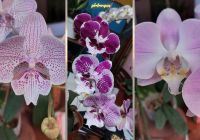, commonly known as the , , mariposa
Phalaenopsis amabilis is native to Island Southeast Asia, New Guinea, and Australia. It has three subspecies: P. a. amabilis, native to the Philippines (Palawan), Malaysia (Borneo), Indonesia (Borneo, Sumatra, and Java); P. a. Molucca, native to the Maluku Islands (Seram and Buru Islands) and Sulawesi of Indonesia; and P. a. ozostomia, native to Papua New Guinea and Australia (north-eastern Queensland).
Phalaenospsis amabilis is one of the three national flowers of Indonesia, where it is known as anggrek bulan (lit. "Moon orchid").
Phalaenopsis amabilis is an epiphytic, rarely lithophytic herb with coarse, flattened, branching roots up to 1 metre (3.3 ft) long and usually 34 millimetres (0.120.16 in) wide. Between two and eight fleshy, dark green, oblong to egg-shaped leaves 150300 millimetres (5.912 in) long and 4070 millimetres (1.62.8 in) wide are arranged in two rows along the stem. The stem is 100300 millimetres (3.912 in) but hidden by the leaf bases. The flowers are arranged on a stiff, arching flowering stem 300750 millimetres (1230 in) long emerging from a leaf base, with a few branches near the tip. Each branch of the flowering stem bears between two and ten white, long-lasting flowers on a stalk (including the ovary) 2035 millimetres (0.791.4 in) long. Each flower is 6070 millimetres (2.42.8 in) long and 5080 millimetres (2.03.1 in) wide with the sepals and petals free from and spreading widely apart from each other. The sepals are egg-shaped, 3040 millimetres (1.21.6 in) long and about 20 millimetres (0.79 in) wide and the petals broadly egg-shaped to almost square, 3040 millimetres (1.21.6 in) long and wide. The labellum is white with yellow and reddish markings, about 25 millimetres (0.98 in) long with three lobes. The side lobes curve upwards and partly surround the column. The middle lobe is cross-shaped with a rounded tip and two long, thread-like wavy arms. There is a large yellow callus near the base of the labellum. Flowering time depends on distribution but occurs from April to December in New Guinea


